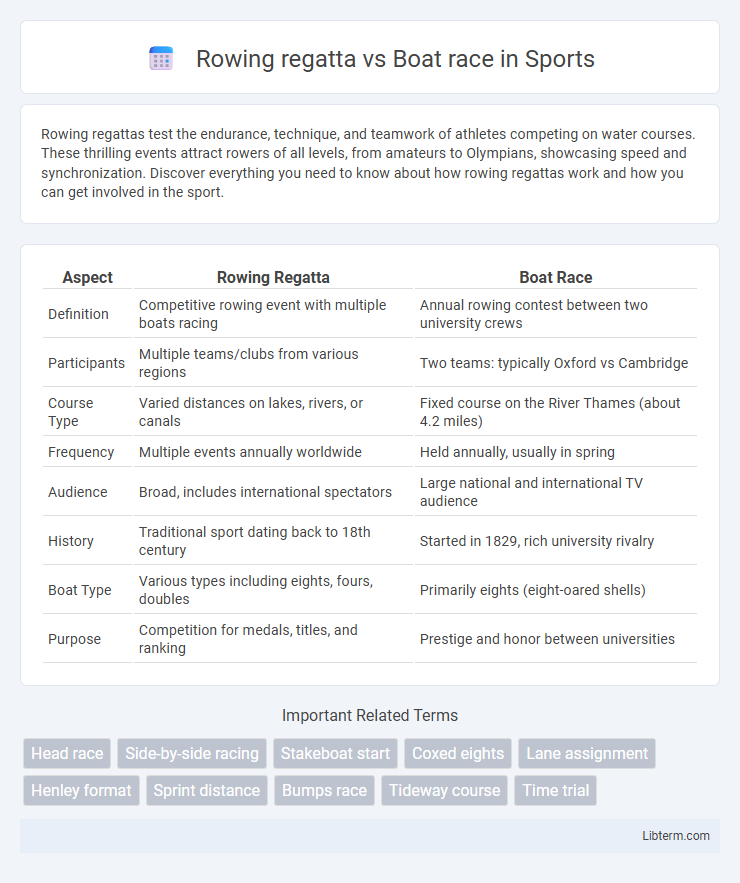Rowing regattas test the endurance, technique, and teamwork of athletes competing on water courses. These thrilling events attract rowers of all levels, from amateurs to Olympians, showcasing speed and synchronization. Discover everything you need to know about how rowing regattas work and how you can get involved in the sport.
Table of Comparison
| Aspect | Rowing Regatta | Boat Race |
|---|---|---|
| Definition | Competitive rowing event with multiple boats racing | Annual rowing contest between two university crews |
| Participants | Multiple teams/clubs from various regions | Two teams: typically Oxford vs Cambridge |
| Course Type | Varied distances on lakes, rivers, or canals | Fixed course on the River Thames (about 4.2 miles) |
| Frequency | Multiple events annually worldwide | Held annually, usually in spring |
| Audience | Broad, includes international spectators | Large national and international TV audience |
| History | Traditional sport dating back to 18th century | Started in 1829, rich university rivalry |
| Boat Type | Various types including eights, fours, doubles | Primarily eights (eight-oared shells) |
| Purpose | Competition for medals, titles, and ranking | Prestige and honor between universities |
Introduction to Rowing Regatta and Boat Race
Rowing regattas are organized competitions featuring multiple race categories, where teams or individuals race rowing boats over set distances on calm water, emphasizing speed and technique. Boat races, often referring to specific traditional contests like the Oxford-Cambridge race, are single, high-profile events with historical and cultural significance, attracting widespread spectator attention. Both showcase rowing prowess but vary in scale, format, and tradition.
Historical Origins and Evolution
Rowing regattas originated in 18th-century England as organized competitive events held on rivers, reflecting the rising popularity of rowing as a sport among the elite class. The Boat Race, specifically the annual competition between Oxford and Cambridge universities since 1829, evolved as an iconic rivalry embodying academic prestige and athleticism. Both events have progressed from informal contests to internationally recognized spectacles, integrating technological advances in boat design and training methodologies.
Key Differences in Race Format
A rowing regatta consists of multiple races with various boat classes competing over standardized distances, often featuring heats, semifinals, and finals, making it a multi-event competition. A boat race, typically between two crews, is a head-to-head contest over a fixed course, emphasizing direct rivalry rather than a series of heats. Regattas highlight diversity in boat types and distances, while boat races focus on a singular, high-stakes championship format.
Popular Events and Locations
The Henley Royal Regatta, held annually on the River Thames in England, is one of the most prestigious rowing regattas, attracting international crews with its historic course and competitive racing. The Oxford-Cambridge Boat Race, also on the Thames, stands out as a high-profile varsity event watched by millions worldwide, showcasing intense rivalry between the two universities. Other notable rowing regattas include the Head of the Charles Regatta in Boston, USA, and the World Rowing Championships, which rotate locations globally, highlighting diverse competitive rowing venues.
Types of Boats Used
Rowing regattas typically feature a variety of boats, including singles, doubles, fours, and eights, each propelled by rowers using oars fixed to the boat with outriggers. Boat races, such as the famous Oxford-Cambridge contest, primarily use eight-oared shells with coxswains coordinating the crew's rhythm and steering. The design of rowing shells emphasizes speed and efficiency on flat water, with narrow hulls and sliding seats tailored for competitive rowing.
Team Structure and Roles
Rowing regattas typically feature multiple teams competing in various boat classes, such as eights, fours, and doubles, each with distinct roles including rowers and a coxswain who steers and leads the crew. Boat races, such as the Oxford-Cambridge event, often involve teams with a fixed boat class like eights, emphasizing a cohesive unit where rowers maintain synchronized rhythm guided by a coxswain. The team structure in regattas can vary widely by boat type, whereas boat races prioritize a consistent crew lineup to maximize coordination and endurance.
Rules and Regulations
Rowing regattas operate under standardized rules set by international bodies like World Rowing, emphasizing vessel classification, course length, and race formats to ensure fairness and safety. Boat races, often traditional university competitions like the Oxford-Cambridge race, follow specific institutional guidelines with unique regulations on crew eligibility, boat specifications, and race conduct. Both events enforce strict rules on crew weight, equipment standards, and anti-doping measures to maintain competitive integrity.
Training and Preparation
Training for rowing regattas involves rigorous endurance and strength conditioning to optimize stroke technique and team synchronization, often incorporating interval training and weightlifting to enhance power and stamina. Boat race preparation emphasizes mental toughness and strategic pacing over long-distance courses, with crews practicing precise timing and communication to navigate variable water conditions and maintain speed. Both disciplines require extensive on-water practice sessions combined with land-based workouts to build cardiovascular fitness and muscle resilience for competitive performance.
Cultural and Social Significance
Rowing regattas often serve as prestigious sporting events bringing together diverse communities to celebrate teamwork, endurance, and tradition in a competitive environment. Boat races, such as the iconic Oxford-Cambridge rivalry, hold deep cultural significance by fostering long-standing institutional pride and social camaraderie, often symbolizing historical legacy. Both events promote social engagement and community identity, enhancing the cultural fabric through shared rituals and public celebrations.
Spectator Experience and Atmosphere
Rowing regattas offer spectators a dynamic and varied experience with multiple races conducted over several hours, allowing close views of powerful strokes and tactical maneuvers along scenic watercourses. In contrast, boat races, often singular marquee events like the Oxford-Cambridge Boat Race, create an intense, festival-like atmosphere with large crowds lining historic riverbanks, vibrant cheering, and a palpable sense of rivalry. The immersive energy and tradition of boat races provide a unique spectator atmosphere, while regattas engage viewers with continuous competitive excitement and diverse crew performances.
Rowing regatta Infographic

 libterm.com
libterm.com